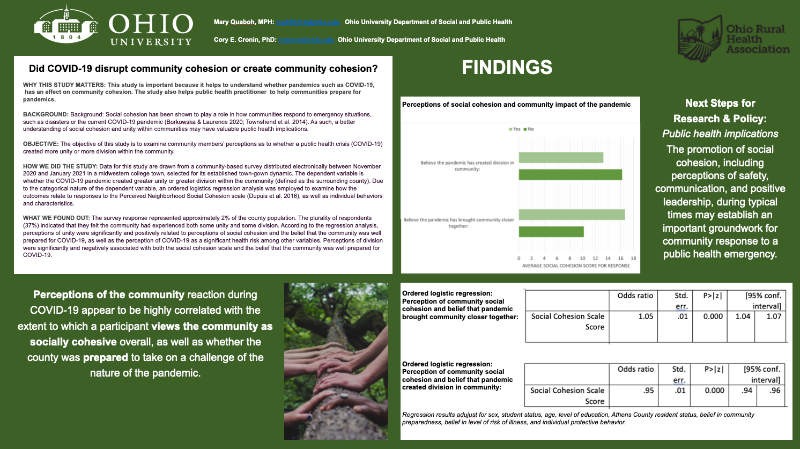
Leading through advocacy, education, and relationships
Did COVID-19 disrupt community cohesion or create community cohesion?
Category: 2021
Author: Mary Quaboh, MPH and Cory E. Cronin, PhD
Institution Affiliation: Ohio University
Background: Social cohesion has been shown to play a role in how communities respond to emergency situations, such as disasters or the current COVID-19 pandemic (Borkowska & Laurence 2020; Townshend et al. 2014). As such, a better understanding of social cohesion and unity within communities may have valuable public health implications. Objectives: The objective of this study is to examine community members’ perceptions as to whether a public health crisis (COVID-19) created unity or division within the community. Methods: Data for this study are drawn from a community-based survey distributed electronically between November 2020 and January 2021 in a midwestern college town, selected for its established town-gown dynamic. The dependent variable is whether the COVID-19 pandemic created greater unity or greater division within the community (defined as the surrounding county). Due to the categorical nature of the dependent variable, an ordered logistics regression analysis was employed to examine how the outcomes relate to responses to the Perceived Neighborhood Social Cohesion scale (Dupuis et al. 2016), as well as individual behaviors and characteristics. Results: The survey response represented approximately 2% of the county population. The plurality of respondents (37%) indicated that they felt the community had experienced both some unity and some division. According to the regression analysis, perceptions of unity were significantly and positively related to perceptions of social cohesion and the belief that the community was well prepared for COVID-19, as well as the perception of COVID-19 as a significant health risk among other variables. Perceptions of division were significantly and negatively associated with both the social cohesion scale and the belief that the community was well prepared for COVID-19. Conclusions: Perceptions of the community reaction during COVID-19 appear to be highly correlated with the extent to which a participant views the community as socially cohesive overall, as well as whether the county was prepared to take on a challenge of the nature of the pandemic. Public health implications: The promotion of social cohesion, including perceptions of safety, communication, and positive leadership, during typical times may establish an important groundwork for community response to a public health emergency.
Watch Video
 Phone: 567-712-0697
Phone: 567-712-0697
